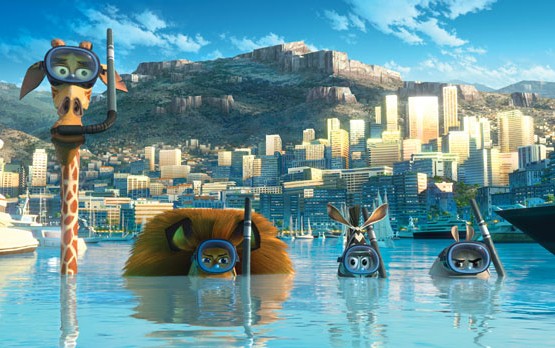Culture
Returning once more to “Madagascar”

Madagascar 3: Europe's Most Wanted
dir. Eric Darnell, Tom McGrath and Conrad Vernon
Release Date: Jun 08, 12
- 1
- 2
- 3
- 4
- 5
- 6
- 7
- 8
- 9
- 10
Reviewing a film like Madagascar 3: Europe’s Most Wanted almost feels redundant, given that market research has already assessed, with far more accuracy than I could hope to, who will see this movie, who won’t, and how to reach maximum profitability with the former. It’s hard not to see the third installment in a successful but not exactly blockbuster franchise as nothing more than such a cynical endeavor. While reasonably enjoyable, the first two Madagascar films came squarely from Dreamworks’ Shrek school of logic: lots of loud noises and bright colors for the kids, combined with some pop culture references and misplaced innuendo for the parents who’d have to take them, in turn guaranteeing that the youthful majority of the audience feels like they get to be in on some grownup jokes they’re not supposed to know about just yet. This all comes at the expense of the genuine exhilaration of imagination. For its part, Europe’s Most Wanted does little to stray from the formula.
One of Madagascar’s long-running hallmarks is its penchant for stunt voice-casting, and this installment is no exception. Still struggling to return home to their beloved Central Park Zoo in New York, the intrepid foursome of Alex the lion (Ben Stiller), Marty the zebra (Chris Rock, screaming nearly every line he gets), Melman the giraffe (David Schwimmer) and Gloria the hippopotamus (Jada Pinkett Smith) end up in Monaco, tasked with picking up the penguins (led by Andy Richter) and the moronic King Julien (Sacha Baron Cohen) en route to America. Everything goes wrong, in one of the film’s many huge set pieces, and they end up pursued by the sadistic Captain DuBois (Frances McDormand), who aspires to mount Alex’s head on her wall. Desperate for an escape, they run away with a ramshackle circus run by the sternly Eastern European tiger Vitaly (Bryan Cranston) and the comely leopard Gia (Jessica Chastain). Interspecies romance, lessons about staying true to your friends and for the most part a lot of loud noises and pretty colors ensue.
There are a few gags in Madagascar 3 that actually stick, in particular the dynamic between Marty and an earnest sea lion who wants to be the animal fired from a cannon, voiced by Martin Short. More often than not, though, the film descends into absolute cacophony, only cooling down momentarily to offer treacly moments of unearned sentimentality, another hallmark of most of Dreamworks’ animated features. People tend to invoke the P-word when talking about great American animation, and often they shouldn’t, as Dreamworks is in a different business. That said, at the very least there’s an obligation to not insult the intelligence of the younger crowds to whom they’re peddling sequels ad infinitum. Most of this third installment feels perfunctory, throwing together sight gags and jokes that kids enjoyed before (the interminable “I Like To Move It” returns once more) for a quick gasp of recognition that ultimately hides the fact that most of the film just plays as lazy.
Even the big moments lack spark, with the exception of one lovely sequence set in Rome’s Coliseum, in which their new, flashier circus goes full-blown neon-rave and makes use of the film’s otherwise unremarkable 3D. There, though, the entire scene is scored to Katy Perry’s “Firework,” which makes not one but two appearances in the final forty minutes of the film to keep things timely and “hip”; that sentiment seems to be the film’s significant modus operandi. Probably most depressing about Madagascar 3: Europe’s Most Wanted is the central idea that the “old circus,” with its simple pleasures of tamed animals and death-defying stunts, is no longer welcome or interesting. Only the new circus, with screaming noises and flashing lights and Katy Perry, seems to be of value. It’s not that I think Madagascar 3 is necessarily the place for children to learn about the value of history and aesthetics, but it’s not really helping matters either.